Practicing the Bridges in Mathematics Grade 4 Student Book Answer Key Unit 2 Module 2 will help students analyze their level of preparation.
Bridges in Mathematics Grade 4 Student Book Answer Key Unit 2 Module 2
Bridges in Mathematics Grade 4 Student Book Unit 2 Module 2 Session 1 Answer Key
Work Place Instructions 2B Division Capture
Each pair of players needs:
- 1 2B Division Capture Record Sheet to share
- 1 spinner overlay to share
- 1 red and 1 blue colored pencil
1. Players each spin the spinner. The player who gets the higher number goes first, and decides whether to use the red or the blue pencil to mark his or her combinations.
2. Players take turns spinning the spinner and using the number spun to complete one of the division problems on the sheet.
- Each player needs to be sure to use his or her own color, blue or red.
- If the box a player needs is already filled, that player loses the turn.
- Players try to capture 3 or 4 boxes in a row, horizontally, vertically, or diagonally.
3. Players continue taking turns until the game board is filled or neither player can use the number he or she spins 3 times in a row.
4. Players then circle the places on the grid where they got 3 or more in a row, and add up their scores. The player with the higher score wins the game.
3 in a row scores 1 point; 4 in a row scores 2 points; and 5 in a row scores 3 points.
Game Variations
A. There are three different record sheets for this game. Each is more challenging than the one before it. If the first and second sheets are easy, try using the third sheet.
Groceries & Laundry
Question 1.
Gregory bought some apricots for his 3 sisters. Each apricot cost 15⊄. He bought 3 apricots for each sister.
a. How much did Gregory spend altogether? Show all your work.
Answer:
Given,
Gregory bought some apricots for his 3 sisters.
Each apricot cost 15⊄. He bought 3 apricots for each sister.
3 × 3 × 15 = 135⊄
Thus Gregory spend 135⊄ altogether.
b. Fill in the bubble beside the equation that best represents this problem (m stands for money).
![]() 3 × (3 × 15⊄) = m
3 × (3 × 15⊄) = m
![]() 3 + 15⊄ + 3 = m
3 + 15⊄ + 3 = m
![]() (3 × 15⊄) – 3 = m
(3 × 15⊄) – 3 = m
Answer:
From the above solution, we can say that
3 × (3 × 15⊄) = m is the equation.
Option A is the correct answer.
Question 2.
Lucia bought 3 pounds of carrots for 75⊄ a pound. She also bought a box of crackers. In all, Lucia spent $4.54.
a. How much did the box of crackers cost? Show all your work.
Answer:
Lucia bought 3 pounds of carrots for 75⊄ a pound.
She also bought a box of crackers. In all, Lucia spent $4.54.
1 dollar = 100 cents
75 cents = 0.75$
$4.54 – 3(0.75$)
4.54 – 2.25 = $2.29
Thus the box of crackers cost $2.25
b. Fill in the bubble beside the equation that best represents this problem (c stands for the cost of the crackers).
![]() $4.54 – c = 75⊄
$4.54 – c = 75⊄
![]() (3 × 75⊄) + c = $4.54
(3 × 75⊄) + c = $4.54
![]() (3 + 75⊄) × c = $4.54
(3 + 75⊄) × c = $4.54
Answer:
(3 × 75⊄) + c = $4.54
Option B is the correct answer.
Question 3.
CHALLENGE DJ is doing laundry in his apartment building. It costs $1.00 to run the washing machine and $1.25 to run the dryer. DJ has 27 quarters. How many loads of laundry can he put through the washer and dryer? Show all your work.
Answer:
Given,
DJ is doing laundry in his apartment building.
It costs $1.00 to run the washing machine and $1.25 to run the dryer.
DJ has 27 quarters.
27 quarters = $6.75
(1.25 × 3) + 3(1.00) = 6.75
Thus he can put 3 loads of laundry through the washer and dryer.
Estimate & Check
For each frame below label each dimension with a regular pencil. Imagine what the area of the rectangle will be once you’ve filled it in. Then check your thinking by making a quick sketch. Write the area of each rectangle you draw in red pencil. Write a multiplication equation to match the rectangle.
ex

Multiplication Equation 5 × 12 = 60
Question 1.
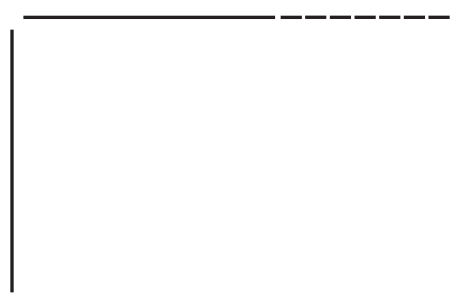
Multiplication Equation _____________
Answer:

(10 × 10) + (10 × 7)
= 100 + 70
= 170
Question 2.

Multiplication Equation _____________
Answer:

(8 × 10) + (8 × 10) + (8 × 4)
= 80 + 80 + 32
= 160 + 32
= 192
Question 3.
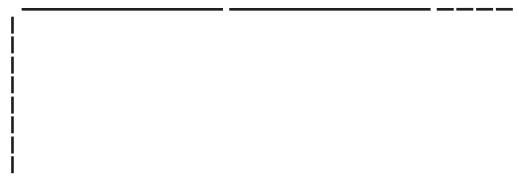
Multiplication Equation _____________
Answer:

(8 × 10) + (8 × 10) + (8 × 4)
= 80 + 80 + 32
= 160 + 32
= 192
Bridges in Mathematics Grade 4 Student Book Unit 2 Module 2 Session 2 Answer Key
Multiplication Arrays
Question 1.
Lida is solving 6 × 15.
a. Sketch and label an open array for 6 × 15.
Answer:

6 × 10 = 60
6 × 5 = 30
60 + 30 = 90
b. What is the product of 6 × 15?
Answer:
6 × 15 = 90
Question 2.
Tomas is solving 3 × 22.
a. Sketch and label an open array for 3 × 22.
Answer:

3 × 10 = 30
3 × 10 = 30
3 × 2 = 6
30 + 30 + 6 = 66
b. What is the product of 3 × 22?
Answer:
3 × 22 = 66
Question 3.
Rowan is solving 7 × 12.
a. Sketch and label an open array for 7 × 12.
Answer:
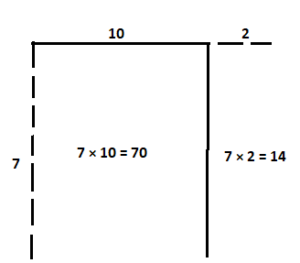
7 × 10 = 70
7 × 2 = 14
70 + 14 = 84
b. What is the product of 7 × 12?
Answer:
7 × 12 = 84
Question 4.
True or False?
a 6 × 15 = (6 × 10) + (6 × 5)
Answer:
6 × 15 = 90
6 × 10 = 60
6 × 5 = 30
(6 × 10) + (6 × 5)
= 60 + 30
= 90
So, the statement is true.
b. 3 × 22 = (3 × 20) + (3 × 10)
Answer:
3 × 22 = 66
(3 × 20) + (3 × 10)
60 + 30 = 90
66 ≠ 90
So, the statement is false.
c. 7 × 12 = (7 × 10) – (7 × 2)
Answer:
7 × 12 = 84
(7 × 10) – (7 × 2)
= 70 – 14
= 56
So, the statement is false.
d. 9 × 17 = (9 × 10) + (9 × 7)
Answer:
9 × 17 = 153
= (9 × 10) + (9 × 7)
= 90 + 63
= 153
So, the statement is true.
Bridges in Mathematics Grade 4 Student Book Unit 2 Module 2 Session 3 Answer Key
Multiplying by Ten, One Hundred & One Thousand
Question 1.
For each problem, a-c:
- Label the dimensions.
- Fill in the area and label it.
- Write a multiplication equation to match.
ex

a.
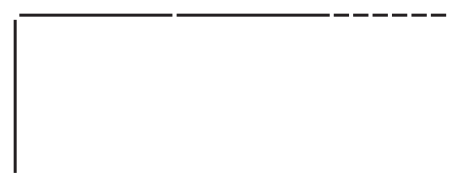
Answer:

10 × 10 = 100
10 × 10 = 100
10 × 6 = 60
100 + 100 + 60 = 260
b.

Answer:

10 × 10 = 100
10 × 10 = 100
10 × 10 = 100
10 × 10 = 100
10 × 5 = 50
100 + 100 + 100 + 100 + 50 = 450
c.

Answer:

10 × 10 = 100
10 × 10 = 100
10 × 10 = 100
10 × 9 = 90
100 + 100 + 100 + 90 = 390
Question 2.
Write the answers.

Answer:
By multiplying 31 and 10 we get 310.
By multiplying 17 and 10 we get 170.
By multiplying 10 and 72 we get 720.
By multiplying 89 and 10 we get 890.
By multiplying 68 and 10 we get 680.
By multiplying 10 and 50 we get 500.
By multiplying 400 and 10 we get 4000.

Question 3.
Fill in the rest of this sentence.
When you multiply any number by 10, _________________
Answer:
When multiplying whole numbers by 10, simply add a 0 to the end of the number, and you will have your answer.
Question 4.
write the numbers.

Answer:

By multiplying 29 and 100 we get 2900.
By multiplying 13 and 100 we get 1300.
By multiplying 62 and 100 we get 6200.
By multiplying 46 and 100 we get 4600.
By multiplying 20 and 100 we get 2000.
By multiplying 61 and 100 we get 6100.
By multiplying 300 and 100 we get 30,000.
By multiplying 35 and 1000 we get 35,000.
By multiplying 19 and 1000 we get 19,000.
By multiplying 40 and 1000 we get 40,000.
Question 5.
The Ladybugs are planting a garden. They have a 25 cm-by-10 cm rectangle for flowers. Each flower needs exactly 1 square centimeter of space. How many flowers can they plant? Show your work.
The Ladybugs can plant ____ flowers.
Answer:
Given,
The Ladybugs are planting a garden. They have a 25 cm-by-10 cm rectangle for flowers.
Area of the rectangle = l × w
A = 25 × 10
= 250 sq. cm
Each flower needs exactly 1 square centimeter of space.
250/1 = 250
The Ladybugs can plant 250 flowers.
Question 6.
CHALLENGE The Ladybugs have a 30 cm-by-10 cm rectangle for pumpkins. Each pumpkin needs exactly 25 square centimeters of space. How many pumpkins can they plant? Show your work on another piece of paper. Include a labeled sketch.
The Ladybugs can plant ____ pumpkins.
Answer:
Given,
The Ladybugs have a 30 cm-by-10 cm rectangle for pumpkins.
30 × 10 = 300
Each pumpkin needs exactly 25 square centimeters of space.
300/25 = 12
The Ladybugs can plant 12 pumpkins.
Multiplication Practice
Question 1.
Solve these problems with mental computation. Write the answers.

Answer:

By multiplying 10 and 3 we get 30.
By multiplying 20 and 3 we get 60.
By multiplying 30 and 3 we get 90.
By multiplying 40 and 3 we get 120.
By multiplying 50 and 3 we get 150.
By multiplying 60 and 3 we get 180.
By multiplying 70 and 3 we get 210.
By multiplying 80 and 3 we get 240.
By multiplying 90 and 3 we get 270.
By multiplying 100 and 3 we get 300.
By multiplying 1000 and 3 we get 3000.
By multiplying 10,000 and 3 we get 30,000.
By multiplying 100,000 and 3 we get 300,000.
Question 2.
Explain how you figured out the answers to the problems above.
Answer: Mental math involves simplifying mathematical equations in one’s head to arrive at an exact or approximate answer.
Question 3.
Solve these problems in your head. Write the answers.
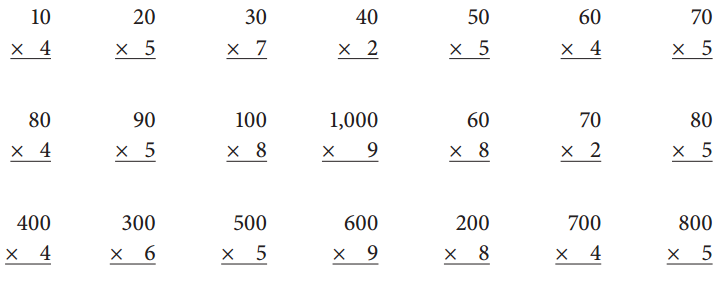
Answer:
10 × 4 = 40
20 × 5 = 100
30 × 7 = 210
40 × 2 = 80
50 × 5 = 250
60 × 4 = 240
70 × 5 = 350
80 × 4 = 320
90 × 5 = 450
100 × 8 = 800
1000 × 9 = 9000
60 × 8 = 480
70 × 2 = 140
80 × 5 = 400
400 × 4 = 1600
300 × 6 = 1800
500 × 5 = 2500
600 × 9 = 5400
200 × 8 = 1600
700 × 4 = 2800
800 × 5 = 4000

Question 4.
CHALLENGE

Answer:

By multiplying 900 by 9 we get 8100.
By multiplying 400 by 12 we get 4800.
By multiplying 800 by 9 we get 7200.
By multiplying 600 by 12 we get 7200.
By multiplying 700 by 11 we get 7700.
By multiplying 800 by 8 we get 6400.
By multiplying 800 by 12 we get 7200.
Bridges in Mathematics Grade 4 Student Book Unit 2 Module 2 Session 4 & 5 Answer Key
Ratio Table Equations
Question 1.
Look at your own ratio table.
Write the entries for rows 1, 2, 3, 10, 20, and 30 as equations.
a. Example: A ratio table for 39 shows 10 across from 390, so we would write 39 × 10 = 390 for row 10.

____ × 1 = ____ ____ × 2 = ____ ____ × 3 = ____
____ × 10 = ____ ____ × 20 = ____ ____ × 30 = ____
Answer:
9 : 351 = 351/9 = 39
39 × 1 = 39
39 × 2 = 78
39 × 3 = 117
39 × 10 = 390
39 × 20 = 780
39 × 30 = 1170
Question 2.
Look at a different ratio table.
Write the entries for rows 1, 2, 3, 10, 20, and 30 as equations.
____ × 1 = ____ ____ × 2 = ____ ____ × 3 = ____
____ × 10 = ____ ____ × 20 = ____ ____ × 30 = ____
Answer:
The number in the ratio table is 15.
15 × 1 = 15
15 × 2 = 30
15 × 3 = 45
15 × 10 = 150
15 × 20 = 300
15 × 30 = 450
Question 3.
Look at a different ratio table.
Write the entries for rows 1, 2, 3, 10, 20, and 30 as equations.
____ × 1 = ____ ____ × 2 = ____ ____ × 3 = ____
____ × 10 = ____ ____ × 20 = ____ ____ × 30 = ____
Answer:
The ratio table is a multiple of 7.
7 × 1 = 7
7 × 2 = 14
7 × 3 = 21
7 × 10 = 70
7 × 20 = 140
7 × 30 = 210
Bridges in Mathematics Grade 4 Student Book Unit 2 Module 2 Session 4 Answer Key
Ratio Table Practice
Question 1.
This is part of a ratio table made by a fourth grade student.
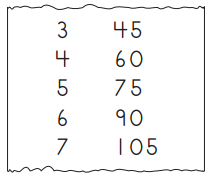
a. What number was the student multiplying for this ratio table? ______
Answer:
3 : 45 = 1 : 15
15 was the student multiplying for this ratio table.
b. What number would come next in each column? ____ and ____
Answer:
8 × 1 : 8 × 15 = 8 : 120
So, the number that would come next in each column is 8 and 120.
Question 2.
Fill in the ratio table below.
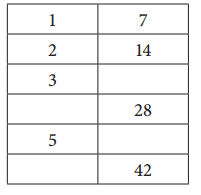
Answer:
The ratio table is a multiple of 7.

Question 3.
Is 21 a prime number? How do you know?
Answer:
No, 21 is not a prime number. The number 21 is divisible by 1, 3, 7, 21.
Question 4.
Fill in the blanks in the table below.
2 × ____ = 28 ____ × 3 = 42 4 × 14 = ____
9 × ____ = 54 ____ × 7 = 63 9 × 8 = ____
___ × 12 = 24 3 × ____ = 36 4 × 12 = ____
Answer:
2 × 14 = 28
14 × 3 = 42
4 × 14 = 64
9 × 6 = 54
9 × 7 = 63
9 × 8 = 72
2 × 12 = 24
3 × 12 = 36
4 × 12 = 48
Bridges in Mathematics Grade 4 Student Book Unit 2 Module 2 Session 5 Answer Key
More Multiplication
Question 1.
Fill in the Multiple Wheel.

Answer:
Multiply the numbers in the wheel by 13.
13 × 10 = 130
13 × 3 = 39
13 × 40 = 520
13 × 2 = 26
13 × 20 = 260
13 × 8 = 104
13 × 4 = 52
13 × 30 = 390
13 × 80 = 1040
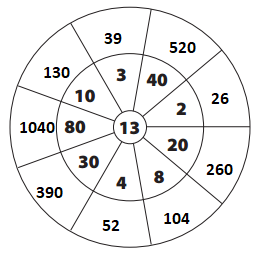
Question 2.
For the problem 22 × 10, which of the following statements is not correct?
![]() 22 × 10 is 10 twenty-twos.
22 × 10 is 10 twenty-twos.
![]() 22 × 10 has to be more than 200 because 20 × 10 = 200.
22 × 10 has to be more than 200 because 20 × 10 = 200.
![]() 22 × 10 is 22 add 0.
22 × 10 is 22 add 0.
![]() 22 × 10 is 22 tens.
22 × 10 is 22 tens.
Answer:
22 × 10 = 220
220 can be written as 22 tens, 10 twenty-twos.
![]() 22 × 10 is 10 twenty-twos.
22 × 10 is 10 twenty-twos.
![]() 22 × 10 has to be more than 200 because 20 × 10 = 200.
22 × 10 has to be more than 200 because 20 × 10 = 200.
![]() 22 × 10 is 22 add 0.
22 × 10 is 22 add 0.
![]() 22 × 10 is 22 tens.
22 × 10 is 22 tens.
Question 3.
Fill in the blanks.

Answer:

By multiplying 10 and 19 we get 190.
By multiplying 45 and 10 we get 450.
By multiplying 21 and 20 we get 420.
By multiplying 12 and 30 we get 360.
By multiplying 24 and 10 we get 240.
By multiplying 20 and 40 we get 800.
By multiplying 84 and 20 we get 1680.